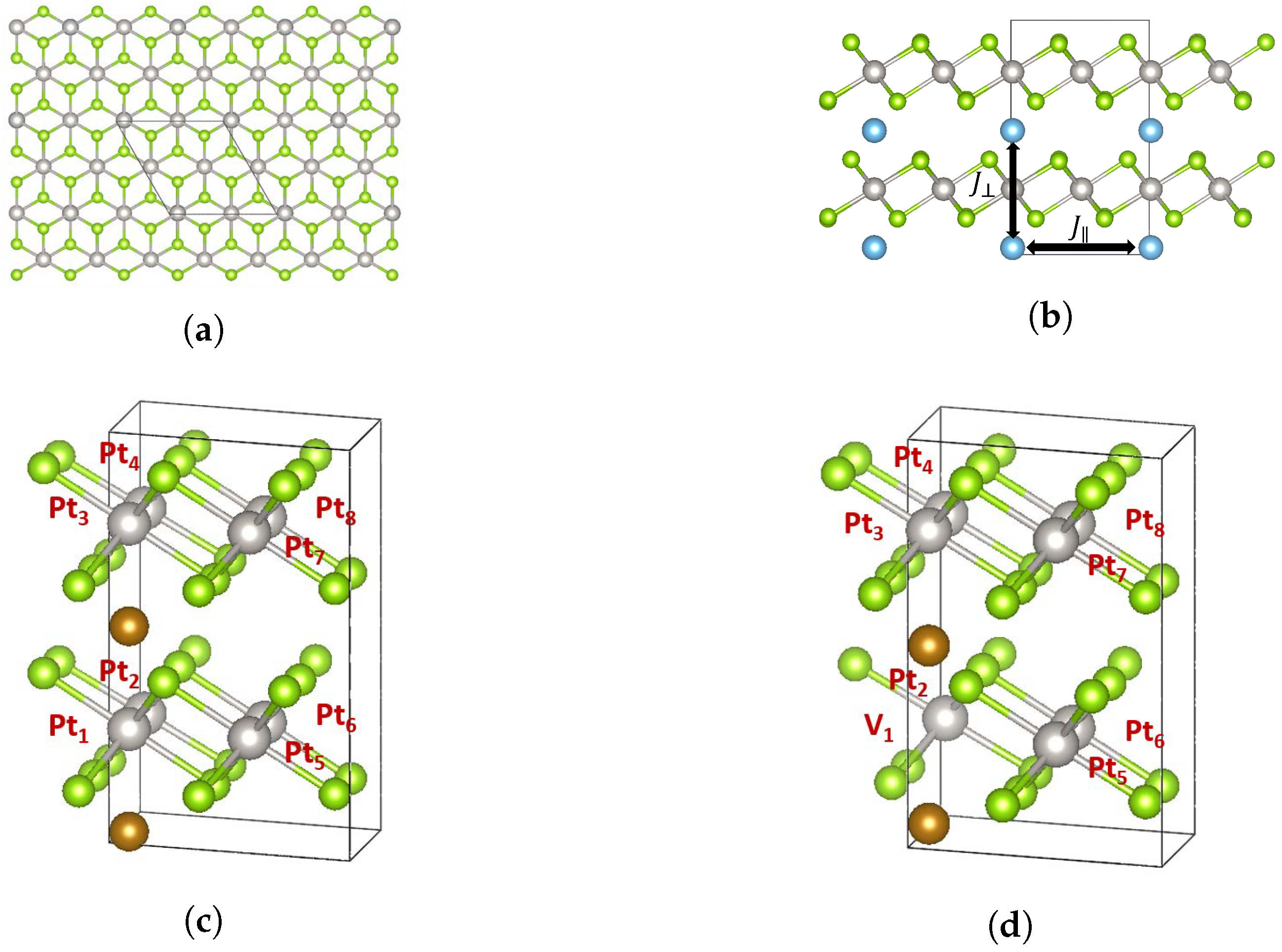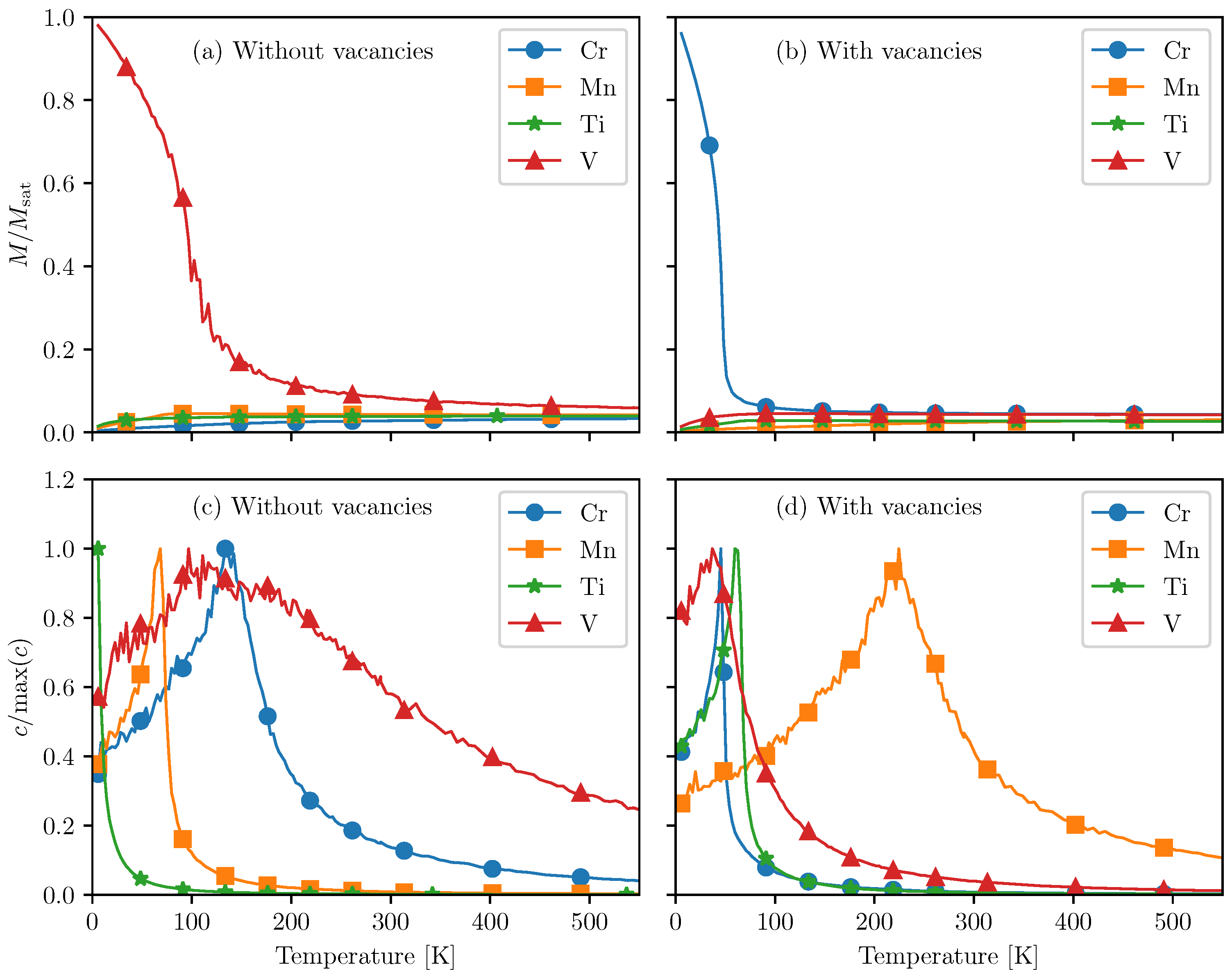Ab-Initio Study of Magnetically Intercalated Platinum Diselenide: The Impact of Platinum Vacancies
Abstract
:1. Introduction
2. Methods
3. Results and Discussion
3.1. Structure of Intercalated PtSe2
3.2. Magnetic Ordering and Critical Temperature
3.3. Exchange Interactions and Magnetic Groundstate
4. Conclusions
Supplementary Materials
Author Contributions
Funding
Data Availability Statement
Acknowledgments
Conflicts of Interest
Abbreviations
| TMD | Transition Metal Dichalcogenide |
| DFT | Density Functional Theory |
| MC | Monte Carlo |
| FM | Ferromagnetic |
| AFM | Anti-ferromagnetic |
Appendix A. DFT Calculations
Appendix A.1. Hubbard U Correction
Appendix A.2. Total Energies of the Magnetic States
References
- Cortie, D.L.; Causer, G.L.; Rule, K.C.; Fritzsche, H.; Kreuzpaintner, W.; Klose, F. Two-Dimensional Magnets: Forgotten History and Recent Progress towards Spintronic Applications. Adv. Funct. Mater. 2020, 30, 1901414. [Google Scholar] [CrossRef]
- McGuire, M.A.; Dixit, H.; Cooper, V.R.; Sales, B.C. Coupling of Crystal Structure and Magnetism in the Layered, Ferromagnetic Insulator CrI3. Chem. Mater. 2015, 27, 612–620. [Google Scholar] [CrossRef]
- Huang, B.; Clark, G.; Navarro-Moratalla, E.; Klein, D.R.; Cheng, R.; Seyler, K.L.; Zhong, D.; Schmidgall, E.; McGuire, M.A.; Cobden, D.H.; et al. Layer-dependent ferromagnetism in a Van der Waals crystal down to the monolayer limit. Nature 2017, 546, 270–273. [Google Scholar] [CrossRef] [Green Version]
- Gong, C.; Li, L.; Li, Z.; Ji, H.; Stern, A.; Xia, Y.; Cao, T.; Bao, W.; Wang, C.; Wang, Y.; et al. Discovery of intrinsic ferromagnetism in two-dimensional van der Waals crystals. Nature 2017, 546, 265–269. [Google Scholar] [CrossRef] [PubMed] [Green Version]
- Torelli, D.; Thygesen, K.S.; Olsen, T. High throughput computational screening for 2D ferromagnetic materials: The critical role of anisotropy and local correlations. 2D Mater. 2019, 6, 045018. [Google Scholar] [CrossRef] [Green Version]
- Tiwari, S.; Vanherck, J.; Van de Put, M.L.; Vandenberghe, W.G.; Soree, B. Computing Curie Temperature of Two-Dimensional Ferromagnets in the Presence of Exchange Anisotropy. 2021. Available online: https://arxiv.org/abs/2105.07958 (accessed on 21 July 2021).
- Tiwari, S.; Van de Put, M.L.; Sorée, B.; Vandenberghe, W.G. Magnetic order and critical temperature of substitutionally doped transition metal dichalcogenide monolayers. NPJ 2D Mater. Appl. 2021, 5, 54. [Google Scholar] [CrossRef]
- Reyntjens, P.D.; Tiwari, S.; Van de Put, M.L.; Sorée, B.; Vandenberghe, W.G. Magnetic properties and critical behavior of magnetically intercalated WSe2: A theoretical study. 2D Mater. 2020, 8, 025009. [Google Scholar] [CrossRef]
- Habib, M.; Muhammad, Z.; Khan, R.; Wu, C.; ur Rehman, Z.; Zhou, Y.; Liu, H.; Song, L. Ferromagnetism in CVT grown tungsten diselenide single crystals with nickel doping. Nanotechnology 2018, 29, 115701. [Google Scholar] [CrossRef] [PubMed]
- Yang, L.; Wu, H.; Zhang, W.; Lou, X.; Xie, Z.; Yu, X.; Liu, Y.; Chang, H. Ta Doping Enhanced Room-Temperature Ferromagnetism in 2D Semiconducting MoTe2 Nanosheets. Adv. Electron. Mater. 2019, 5, 1900552. [Google Scholar] [CrossRef]
- Mishra, R.; Zhou, W.; Pennycook, S.J.; Pantelides, S.T.; Idrobo, J.C. Long-range ferromagnetic ordering in manganese-doped two-dimensional dichalcogenides. Phys. Rev. B 2013, 88, 144409. [Google Scholar] [CrossRef]
- Ramasubramaniam, A.; Naveh, D. Mn-doped monolayer MoS2: An atomically thin dilute magnetic semiconductor. Phys. Rev. B 2013, 87, 195201. [Google Scholar] [CrossRef]
- Yun, S.J.; Duong, D.L.; Ha, D.M.; Singh, K.; Phan, T.L.; Choi, W.; Kim, Y.M.; Lee, Y.H. Ferromagnetic Order at Room Temperature in Monolayer WSe2 Semiconductor via Vanadium Dopant. Adv. Sci. 2020, 7, 1903076. [Google Scholar] [CrossRef] [Green Version]
- Yue, Q.; Chang, S.; Qin, S.; Li, J. Functionalization of monolayer MoS2 by substitutional doping: A first-principles study. Phys. Lett. A 2013, 377, 1362–1367. [Google Scholar] [CrossRef]
- Luo, P.; Zhuge, F.; Zhang, Q.; Chen, Y.; Lv, L.; Huang, Y.; Li, H.; Zhai, T. Doping engineering and functionalization of two-dimensional metal chalcogenides. Nanoscale Horiz. 2019, 4, 26–51. [Google Scholar] [CrossRef] [PubMed]
- Fei, Z.; Huang, B.; Malinowski, P.; Wang, W.; Song, T.; Sanchez, J.; Yao, W.; Xiao, D.; Zhu, X.; May, A.F.; et al. Two-dimensional itinerant ferromagnetism in atomically thin Fe3GeTe2. Nat. Mater. 2018, 17, 778–782. [Google Scholar] [CrossRef] [PubMed] [Green Version]
- Guo, G.Y.; Liang, W.Y. The electronic structures of platinum dichalcogenides: PtS2, PtSe2 and PtTe2. J. Phys. C Solid State Phys. 1986, 19, 995–1008. [Google Scholar] [CrossRef]
- Wang, Y.; Li, L.; Yao, W.; Song, S.; Sun, J.T.; Pan, J.; Ren, X.; Li, C.; Okunishi, E.; Wang, Y.Q.; et al. Monolayer PtSe2, a New Semiconducting Transition-Metal-Dichalcogenide, Epitaxially Grown by Direct Selenization of Pt. Nano Lett. 2015, 15, 4013–4018. [Google Scholar] [CrossRef] [PubMed]
- Shawkat, M.S.; Gil, J.; Han, S.S.; Ko, T.J.; Wang, M.; Dev, D.; Kwon, J.; Lee, G.H.; Oh, K.H.; Chung, H.S.; et al. Thickness-Independent Semiconducting-to-Metallic Conversion in Wafer-Scale Two-Dimensional PtSe2 Layers by Plasma-Driven Chalcogen Defect Engineering. ACS Appl. Mater. Interfaces 2020, 12, 14341–14351. [Google Scholar] [CrossRef] [PubMed]
- Mermin, N.D.; Wagner, H. Absence of Ferromagnetism or Antiferromagnetism in One- or Two-Dimensional Isotropic Heisenberg Models. Phys. Rev. Lett. 1966, 17, 1133–1136. [Google Scholar] [CrossRef]
- Kar, M.; Sarkar, R.; Pal, S.; Sarkar, P. Engineering the magnetic properties of PtSe2 monolayer through transition metal doping. J. Phys. Condens. Matter 2019, 31, 145502. [Google Scholar] [CrossRef] [PubMed]
- Avsar, A.; Cheon, C.Y.; Pizzochero, M.; Tripathi, M.; Ciarrocchi, A.; Yazyev, O.V.; Kis, A. Probing magnetism in atomically thin semiconducting PtSe2. Nat. Commun. 2020, 11, 4806. [Google Scholar] [CrossRef] [PubMed]
- Gao, J.; Cheng, Y.; Tian, T.; Hu, X.; Zeng, K.; Zhang, G.; Zhang, Y.W. Structure, Stability, and Kinetics of Vacancy Defects in Monolayer PtSe2: A First-Principles Study. ACS Omega 2017, 2, 8640–8648. [Google Scholar] [CrossRef] [PubMed] [Green Version]
- Zheng, H.; Choi, Y.; Baniasadi, F.; Hu, D.; Jiao, L.; Park, K.; Tao, C. Visualization of point defects in ultrathin layered 1T-PtSe2. 2D Mater. 2019, 6, 041005. [Google Scholar] [CrossRef]
- Tiwari, S.; Van de Put, M.L.; Sorée, B.; Vandenberghe, W.G. Critical behavior of the ferromagnets CrI3, CrBr3, and CrGeTe3 and the antiferromagnet FeCl2: A detailed first-principles study. Phys. Rev. B 2021, 103, 014432. [Google Scholar] [CrossRef]
- Friend, R.; Yoffe, A. Electronic properties of intercalation complexes of the transition metal dichalcogenides. Adv. Phys. 1987, 36, 1–94. [Google Scholar] [CrossRef]
- Parkin, S.S.P.; Marseglia, E.A.; Brown, P.J. Magnetisation density distribution in Mn1/4TaS2: Observation of conduction electron spin polarisation. J. Phys. C Solid State Phys. 1983, 16, 2749–2764. [Google Scholar] [CrossRef]
- Anderson, P.W. Antiferromagnetism. Theory of Superexchange Interaction. Phys. Rev. 1950, 79, 350–356. [Google Scholar] [CrossRef]
- Kresse, G.; Furthmüller, J. Efficiency of ab-initio total energy calculations for metals and semiconductors using a plane-wave basis set. Comput. Mater. Sci. 1996, 6, 15–50. [Google Scholar] [CrossRef]
- Kresse, G.; Furthmüller, J. Efficient iterative schemes for ab initio total-energy calculations using a plane-wave basis set. Phys. Rev. B 1996, 54, 11169–11186. [Google Scholar] [CrossRef]
- Kresse, G.; Hafner, J. Ab initio molecular dynamics for liquid metals. Phys. Rev. B 1993, 47, 558–561. [Google Scholar] [CrossRef]
- Kresse, G.; Hafner, J. Ab initio molecular-dynamics simulation of the liquid-metal–amorphous-semiconductor transition in germanium. Phys. Rev. B 1994, 49, 14251–14269. [Google Scholar] [CrossRef] [PubMed]
- Blöchl, P.E. Projector augmented-wave method. Phys. Rev. B 1994, 50, 17953–17979. [Google Scholar] [CrossRef] [Green Version]
- Perdew, J.P.; Burke, K.; Ernzerhof, M. Generalized Gradient Approximation Made Simple. Phys. Rev. Lett. 1996, 77, 3865–3868. [Google Scholar] [CrossRef] [PubMed] [Green Version]
- Grimme, S.; Antony, J.; Ehrlich, S.; Krieg, H. A consistent and accurate ab initio parametrization of density functional dispersion correction (DFT-D) for the 94 elements H-Pu. J. Chem. Phys. 2010, 132, 154104. [Google Scholar] [CrossRef] [PubMed] [Green Version]
- Dudarev, S.L.; Botton, G.A.; Savrasov, S.Y.; Humphreys, C.J.; Sutton, A.P. Electron-energy-loss spectra and the structural stability of nickel oxide: An LSDA+U study. Phys. Rev. B 1998, 57, 1505–1509. [Google Scholar] [CrossRef]
- Cococcioni, M.; de Gironcoli, S. Linear response approach to the calculation of the effective interaction parameters in the LDA + U method. Phys. Rev. B 2005, 71, 035105. [Google Scholar] [CrossRef] [Green Version]



| Intercalant | Ti | V | Cr | Mn | ||||
|---|---|---|---|---|---|---|---|---|
| Pt Vacancy Yes/No | No | Yes | No | Yes | No | Yes | No | Yes |
| Formation energy (eV) | −0.39 | −2.09 | 0.77 | −0.81 | 1.44 | 0.12 | 1.27 | −0.06 |
| U-value (eV) | 4.23 | 3.86 | 4.45 | 4.01 | 5.03 | 3.72 | 6.80 | 5.18 |
| Magnetic moment () | 1.52 | 0.60 | 2.77 | 2.6 | 3.90 | 3.55 | 4.44 | 4.26 |
| (/) | 0.05 | −3.91 | 3.07 | 0.71 | −0.65 | 0.04 | −0.09 | −0.82 |
| (/) | −0.26 | 2.79 | 0.07 | −0.09 | −0.20 | 0.25 | 0.07 | −0.25 |
| (/) | 0.02 | −5.16 | 3.25 | 0.72 | −0.54 | 0.02 | −0.10 | −0.75 |
| (/) | −0.28 | 3.33 | 0.06 | −0.10 | −0.16 | 0.24 | 0.07 | −0.20 |
| D (/) | −0.04 | 2.31 | 0.33 | 0.04 | 0.38 | −0.02 | −0.02 | 0.36 |
| () | — | — | 111 | — | — | 45 | — | — |
| (K) | <0.01 | 63 | — | 32 | 133 | — | 68 | 221 |
Publisher’s Note: MDPI stays neutral with regard to jurisdictional claims in published maps and institutional affiliations. |
© 2021 by the authors. Licensee MDPI, Basel, Switzerland. This article is an open access article distributed under the terms and conditions of the Creative Commons Attribution (CC BY) license (https://creativecommons.org/licenses/by/4.0/).
Share and Cite
Reyntjens, P.D.; Tiwari, S.; Van de Put, M.L.; Sorée, B.; Vandenberghe, W.G. Ab-Initio Study of Magnetically Intercalated Platinum Diselenide: The Impact of Platinum Vacancies. Materials 2021, 14, 4167. https://doi.org/10.3390/ma14154167
Reyntjens PD, Tiwari S, Van de Put ML, Sorée B, Vandenberghe WG. Ab-Initio Study of Magnetically Intercalated Platinum Diselenide: The Impact of Platinum Vacancies. Materials. 2021; 14(15):4167. https://doi.org/10.3390/ma14154167
Chicago/Turabian StyleReyntjens, Peter D., Sabyasachi Tiwari, Maarten L. Van de Put, Bart Sorée, and William G. Vandenberghe. 2021. "Ab-Initio Study of Magnetically Intercalated Platinum Diselenide: The Impact of Platinum Vacancies" Materials 14, no. 15: 4167. https://doi.org/10.3390/ma14154167
APA StyleReyntjens, P. D., Tiwari, S., Van de Put, M. L., Sorée, B., & Vandenberghe, W. G. (2021). Ab-Initio Study of Magnetically Intercalated Platinum Diselenide: The Impact of Platinum Vacancies. Materials, 14(15), 4167. https://doi.org/10.3390/ma14154167






